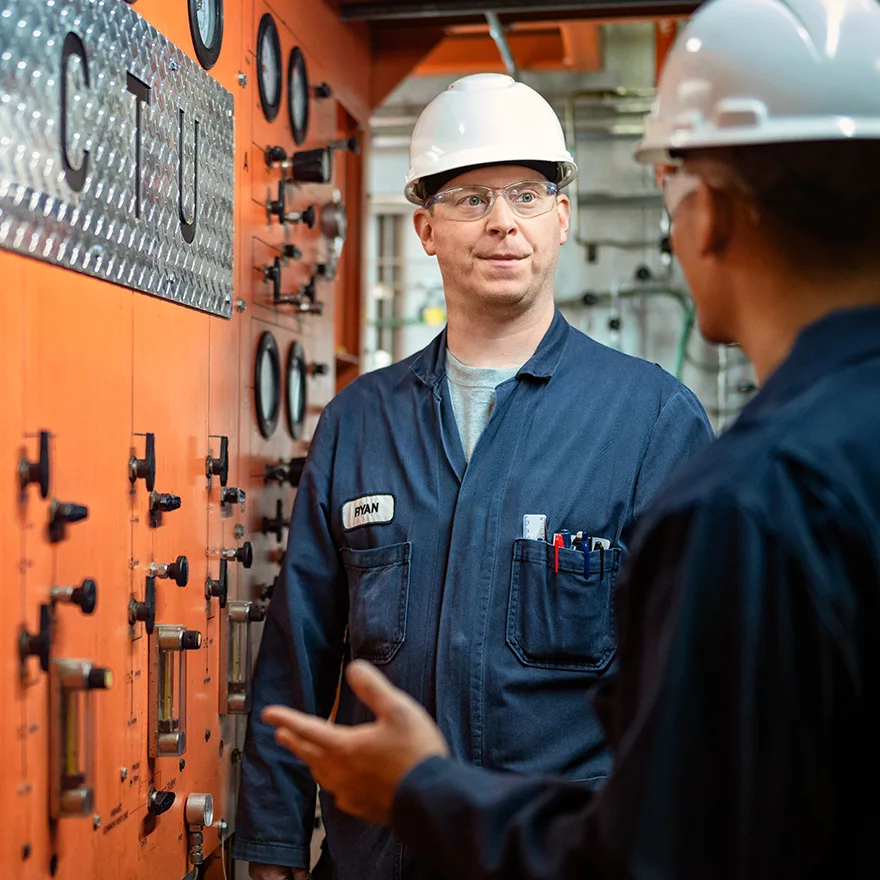
Since the formation of the Pathways Alliance in 2021, significant early progress has been made on our path to net zero. Following are some frequently asked questions about the work so far:
What are the Pathways Alliance decarbonization plans?
To help Canada meet its climate goals, oil sands producers are working together and with governments on an ambitious and actionable plan to help Canada meet its emissions reduction commitments.
This plan will meaningfully reduce greenhouse gas emissions from oil sands operations by 22 million tonnes per year by 2030 and achieve a goal of net zero emissions by 2050.
Our proposed foundational project is a carbon capture and storage (CCS) network and CO₂ pipeline which would gather captured CO₂ from more than 20 oil sands facilities (14 to start) and transport it to a hub in the Cold Lake area of Alberta for safe underground storage. The line would also be available to other industries in the region interested in capturing and storing CO₂.
Our CCS project alone – which would be one of the largest in the world – could reduce net carbon dioxide emissions by about 10 megatonnes per year by 2030 from the first 14 facilities and the engineering work is well underway to get us ready for construction.
How much does the Pathways Alliance intend to spend on these projects?
With anticipated co-funding support from Canadian governments, Pathways Alliance recently announced plans to invest $24.1 billion before 2030 in the first phase of its plan.
Approximately $16.5 billion will support a proposed carbon capture and storage network in northeastern Alberta that, when constructed, will be among the largest facilities in the world. Another $7.6 billion investment is planned on major emissions reduction projects and technologies.
Why haven’t we seen the bulk of that money spent yet?
A CCS project of this size is a huge undertaking that requires significant up-front work and a strong partnership between industry and government to proceed.
In fact, the spending profile on this CCS project follows the way capital is invested for most major infrastructure projects.
The first phase – that we are in now – will see investments in the tens of millions of dollars for feasibility studies, environmental assessments, and early engineering work.
The next phase after final investment decisions are made would see hundreds of millions spent on procurement of materials and services.
Finally, you would be looking at the largest portion of investment in the billions during the construction phases.
We continue to work with the federal and Alberta governments to ensure Canada’s co-funding programs and regulatory environment for CCS are globally competitive and that emissions reduction targets for our industry are realistic and achievable.
At the same time, it is impossible to invest in the construction of these projects because they have not been approved by governments. We are currently working on all the items governments require for regulatory applications, with plans to file our application in late 2023.
What still needs to come together to proceed with constructing these projects?
There are a few things.
First, we are encouraged that governments recognize that for projects like this to proceed requires they must co-invest alongside industry and that those government investments must be competitive with other jurisdictions like Norway, the Netherlands and especially the United States.
The federal government has acknowledged that Canada’s recently announced support for CCS projects falls quite short of what the United States has implemented through the recently announced Inflation Reduction Act and signalled that they will need to invest more. However, the level of co-investment has not yet been announced.
The federal government’s Investment Tax Credit, while a proposed good first step, has not yet been introduced as legislation, nor have other mechanisms they have floated. We are also eagerly anticipating hearing from the provincial government about the level of support they may be providing.
Second, for this CCS project to proceed, Pathways Alliance requires the Alberta government to allocate underground storage space for carbon sequestration. While we are encouraged the government has approved our storage space allocation for further evaluation, we don’t have final approval.
Third, to submit a regulatory application for our hub and pipeline, governments require a significant amount of engineering and scientific documents. For example, the government requires two seasons of environmental field work data to be part of the application. That work is underway but not yet complete.
Finally, it is critical that we meaningfully consult with Indigenous communities on the project. Early engagement has begun.
What is happening while we wait for those regulatory pieces to come together?
We’re progressing work to make sure we’re ready to make an investment decision and start building as soon as the necessary financial and regulatory conditions are in place.
We are doing everything we can to do that early work in anticipation that the necessary conditions will allow us to proceed.
Pre-work on the Pathways Alliance foundational CCS project to date:
- Early engagement with more than 20 Indigenous communities along the proposed CO₂ transportation and storage network corridor and a commitment to meaningful engagement throughout the full cycle of the network’s operations.
- Selected by the Government of Alberta to continue exploratory work on the Alliance’s ambitious CCS hub to safely and permanently store CO₂ captured from 20+ oil sands facilities and other interested industries in northern Alberta – more detailed work to evaluate the storage zone will soon begin.
- Conducting engineering studies for the phase 1 CO₂ capture facilities.
- Nine carbon capture feasibility studies involving member companies have been completed on oil sands sites, with engineering work advancing.
- Completed pre-engineering work on the 400-kilometre pipeline that will carry captured CO₂ to the storage hub; more detailed engineering work is about to begin.
- Environmental field programs are underway to support regulatory application submissions for the proposed CO₂ transportation line and storage network. The Alliance is planning to submit those applications in late Q4 of 2023.
Is Pathways investing in decarbonization projects this year?
Absolutely. Here are just a few examples of decarbonization projects under way this year by Pathways Alliance member companies:
Suncor
- Fuel-switching that will replace coke-fired boilers with significantly lower-emission cogeneration units. This is a $1.4 billion project.
- Allocating approximately 10% of their annual capital budget over the medium term (2022-2025) to investments that advance our low-carbon energy offerings.
Cenovus
- Completed feasibility study for carbon capture at Christina Lake.
- Evaluated feasibility of carbon capture at the Elmworth gas plant as well as the Minnedosa Ethanol Plant, including the drilling and testing of a CO₂ sequestration appraisal well at Minnedosa.
- Initiated a technology screening study to determine the optimal CO₂ capture technology at the Lloydminster Upgrader.
- Completed pre-FEED studies for commercial‑scale carbon capture applications at two Cenovus assets, working with Svante.
- Committed to a power purchase agreement (PPA) to buy renewable electricity and associated emissions offsets.
Canadian Natural
- Piloting solvent enhanced oil recovery technology on its thermal in situ assets with an objective to increase bitumen production, reduce the Steam to Oil Ratio (“SOR”), reduce GHG intensity and realize high solvent recovery. This technology has the potential for application throughout the Canadian Natural’s extensive thermal in situ asset base.
- Canadian Natural is progressing with engineering and design of a commercial scale solvent SAGD pad development at Kirby North, which is targeted to commence solvent injection in early 2024.
- Canadian Natural’s solvent pilot in the Primrose steam flood area began solvent injection in November 2021 with plans to continue for approximately two years to achieve targeted SOR and GHG intensity reductions of 40% to 45%, with solvent recovery greater than 70%. The Company is seeing positive operating results to date, including SOR reductions of approximately 50%.
Imperial
- Progressing Grand Rapids development at Cold Lake, using steam-reducing technology (SA-SAGD solvent-assisted, steam-assisted gravity drainage) as well as other solvent technologies.
- Expanding implementation of boiler flue gas technology at Kearl.
- Pursuing CCS emissions reduction opportunity that captures efficiencies with Cold Lake operations.
Conoco Phillips Canada
- Various engineering studies are underway to explore operational efficiencies (facilities optimization, capture), while several field pilots are under way (steam drive + gas, steam additives, Warm Applied Solvent Process (WASP)).
- Through COSIA participation, Natural Gas Decarbonization, Small Modular Nuclear Reactors (SMRs) and transformational capture technologies are being explored.
MEG Energy
- Carbon capture and sequestration conceptual studies and initial Pre-FEED activities.
- Shallow sequestration scoping studies.

Our people, their stories
Passionate, dedicated people are behind every innovation and every step forward.